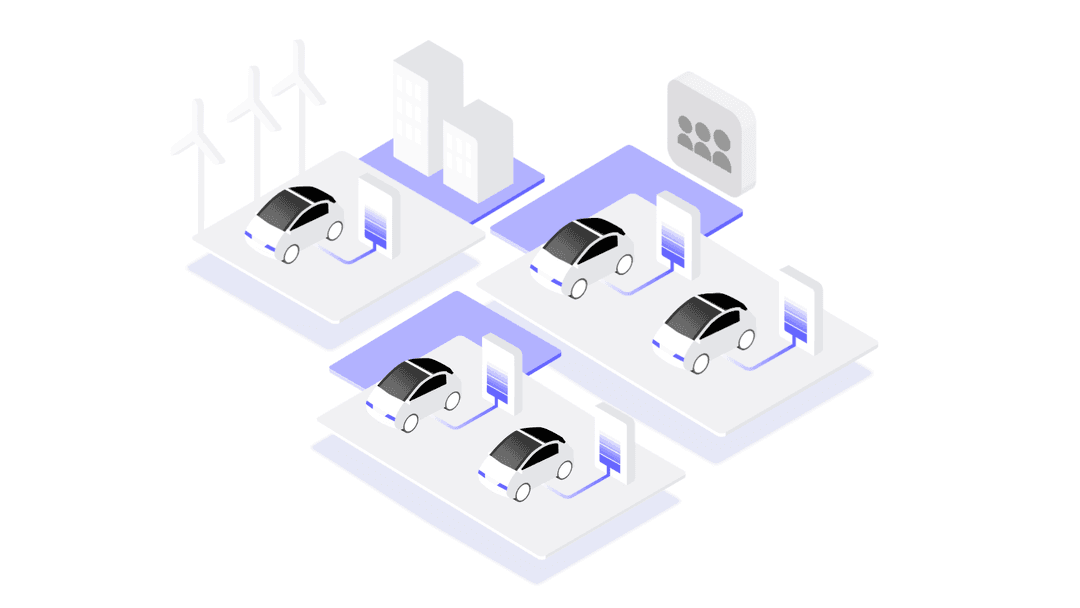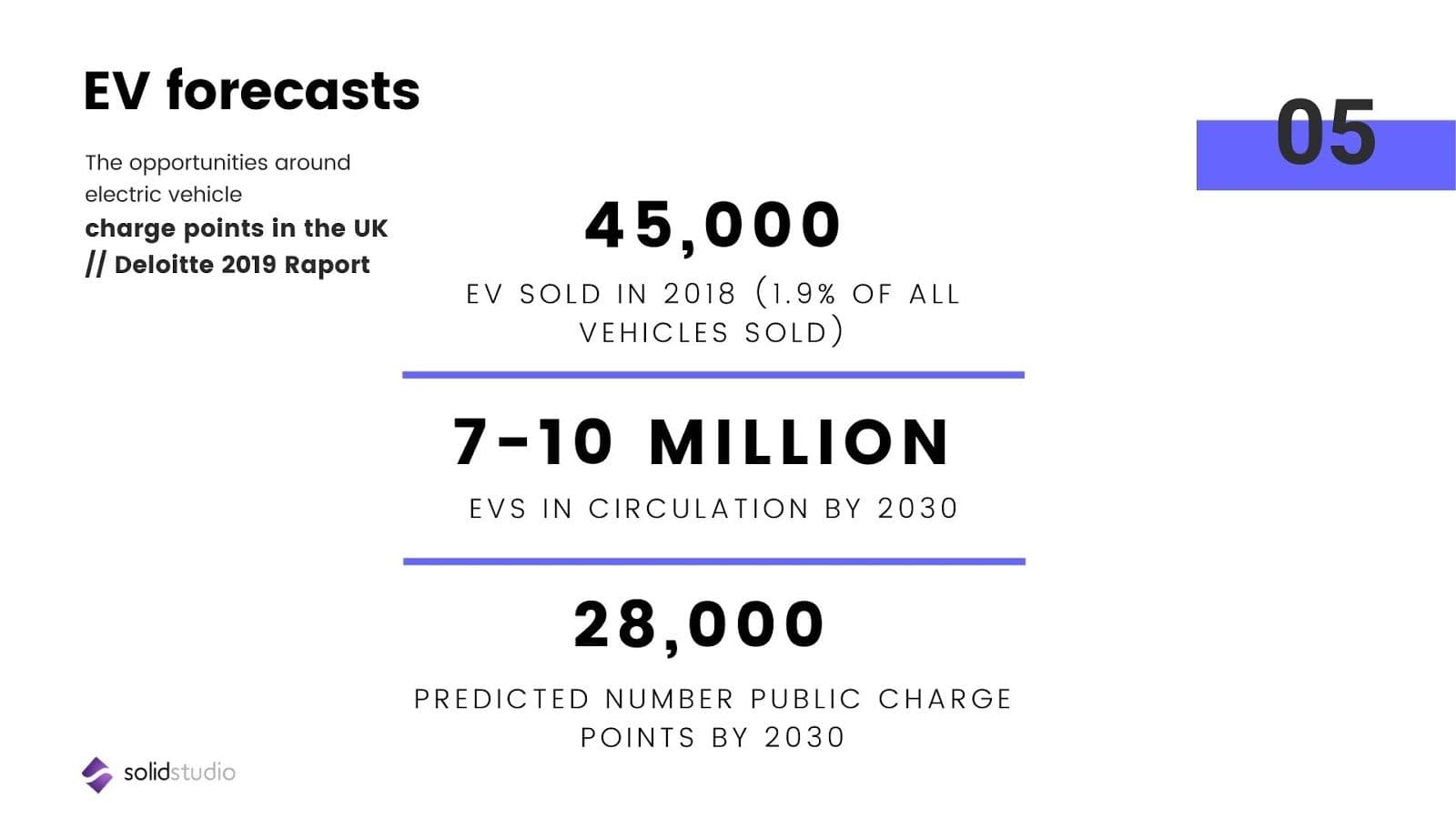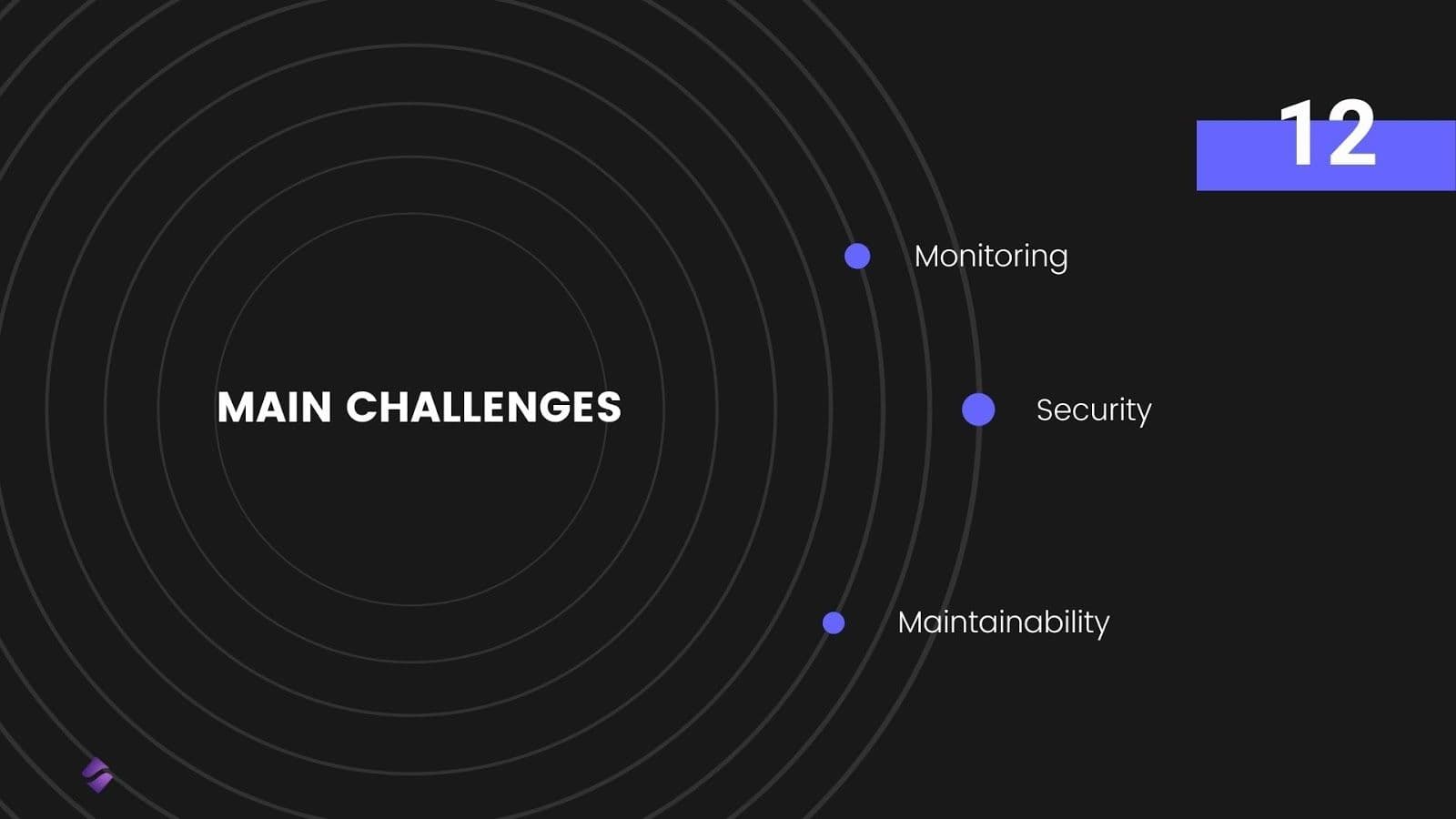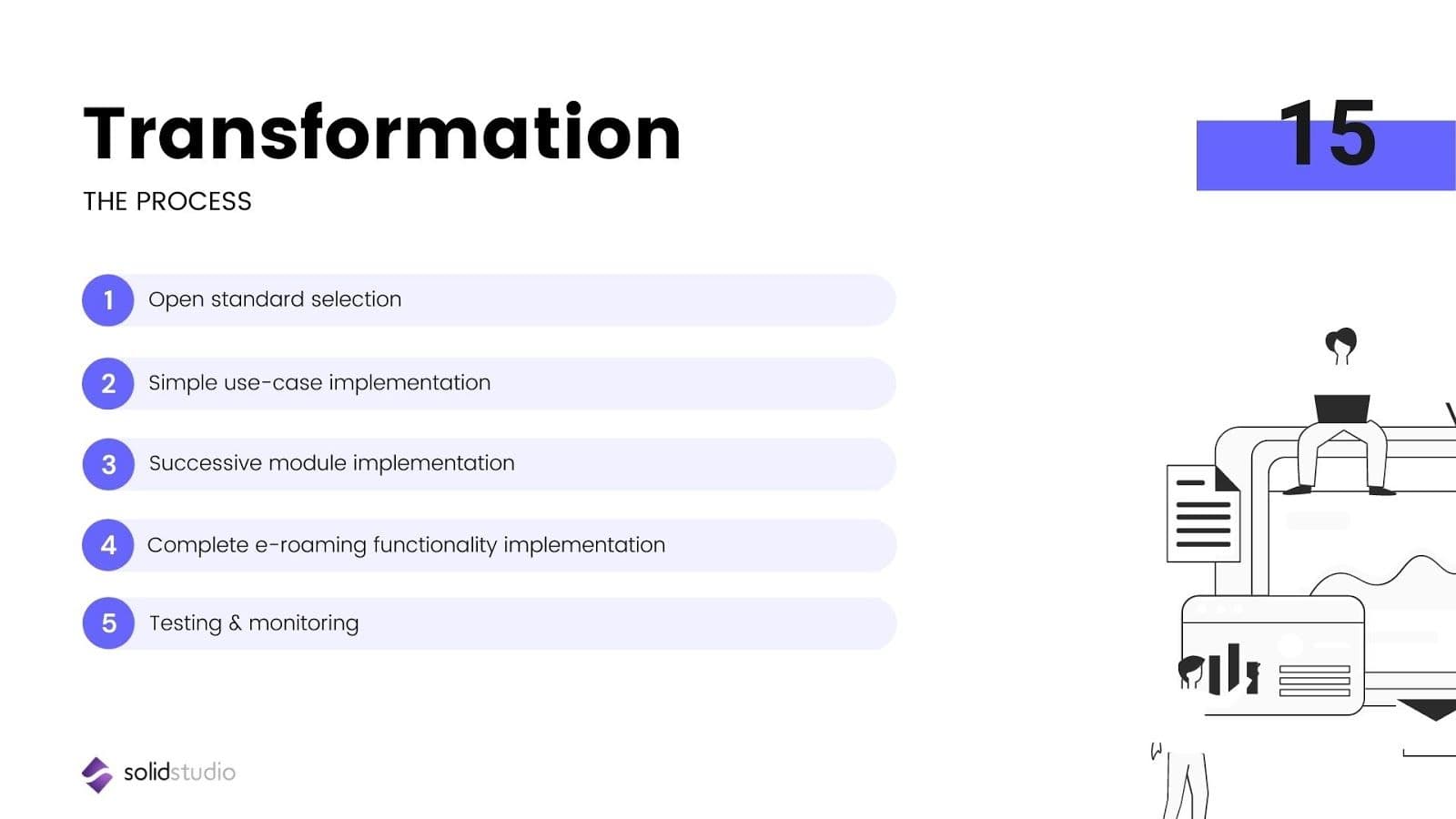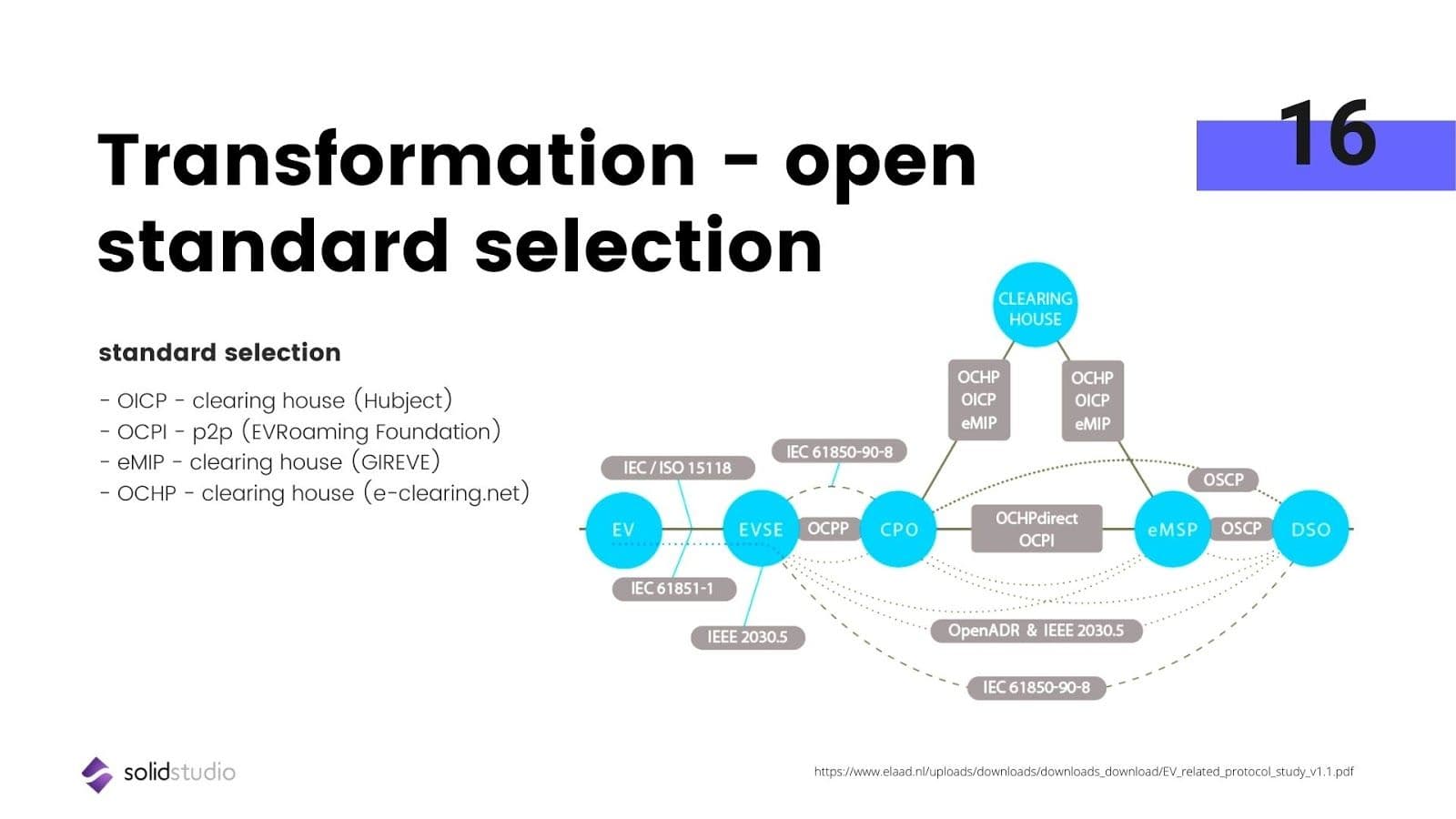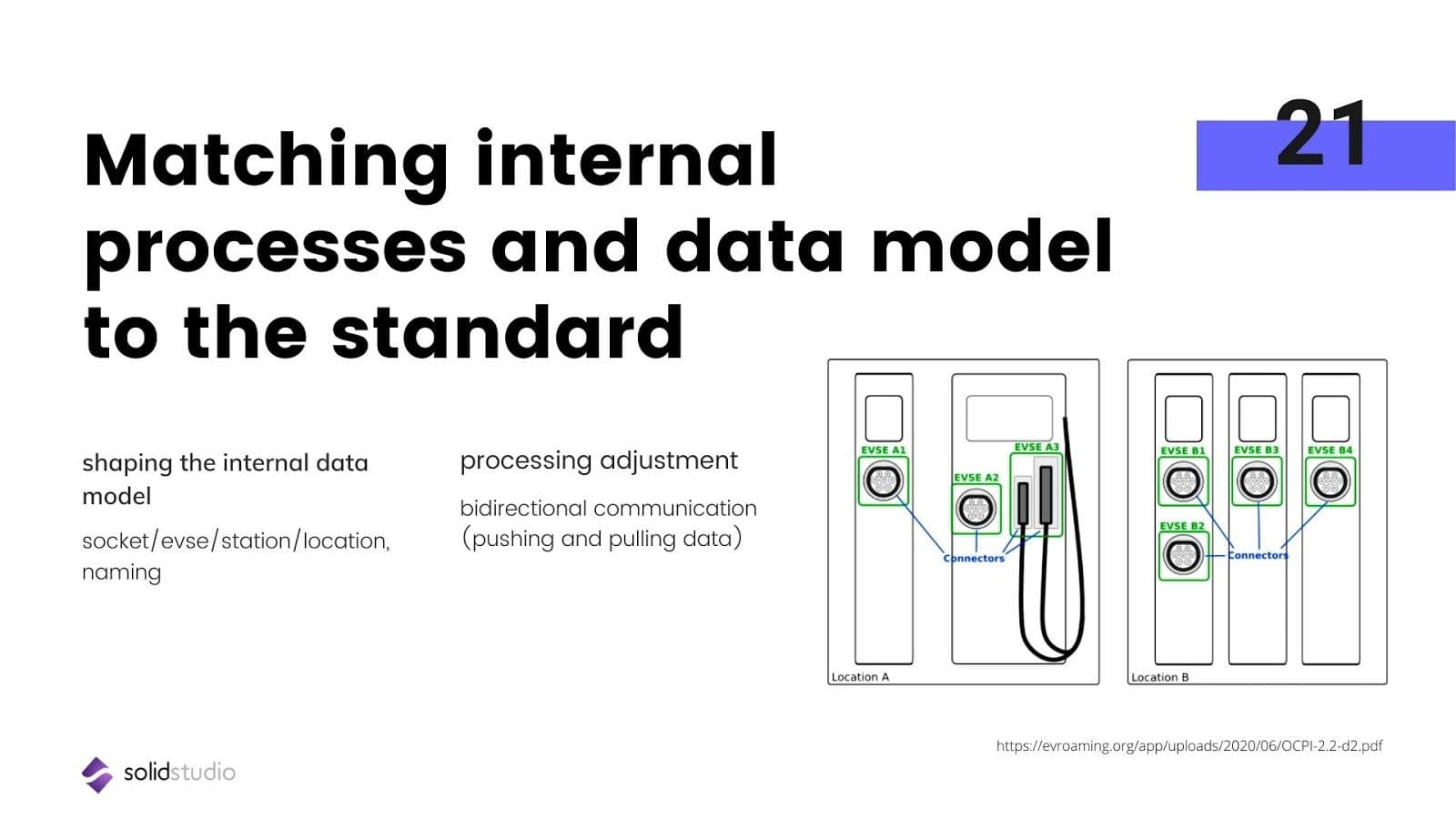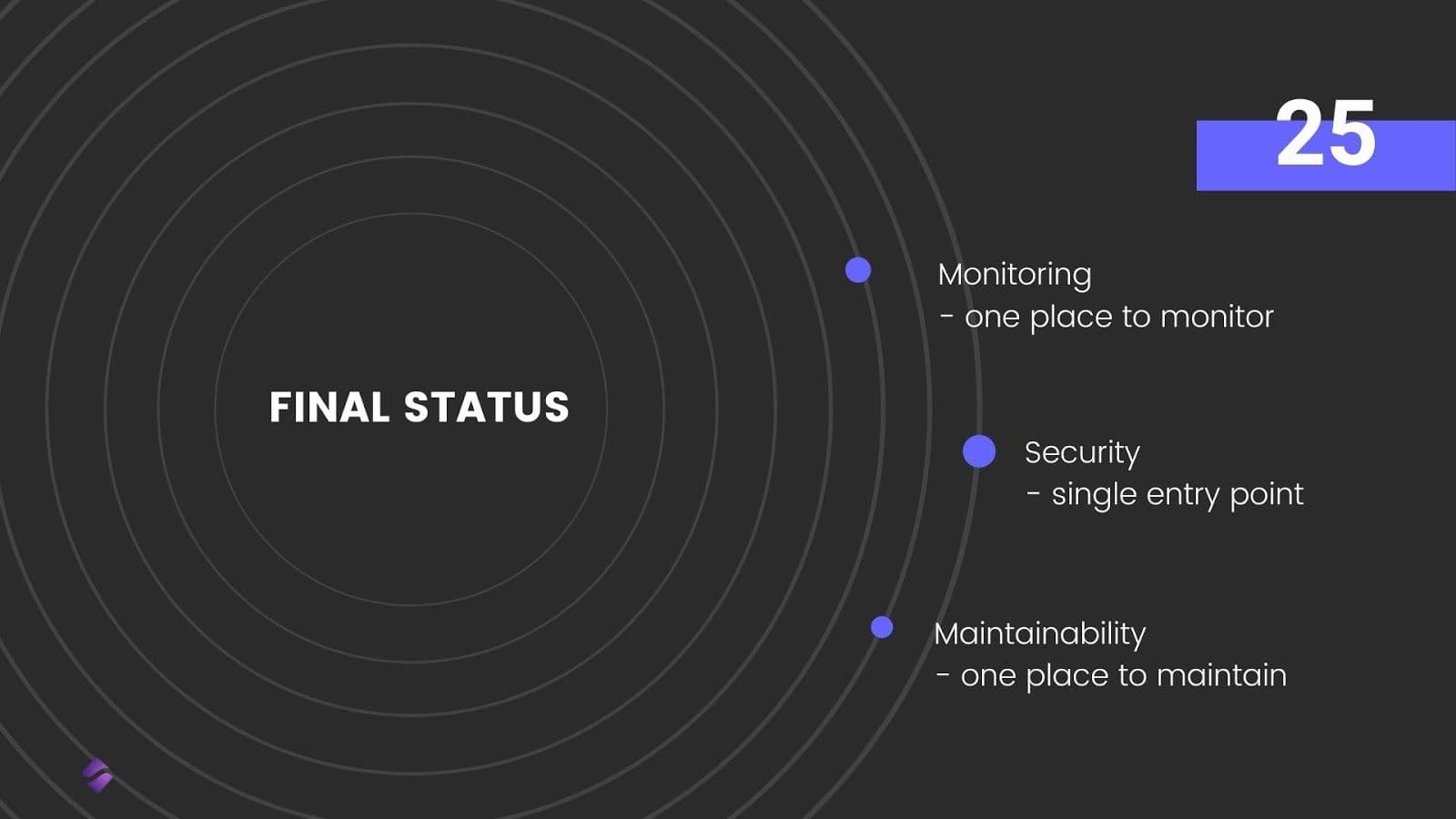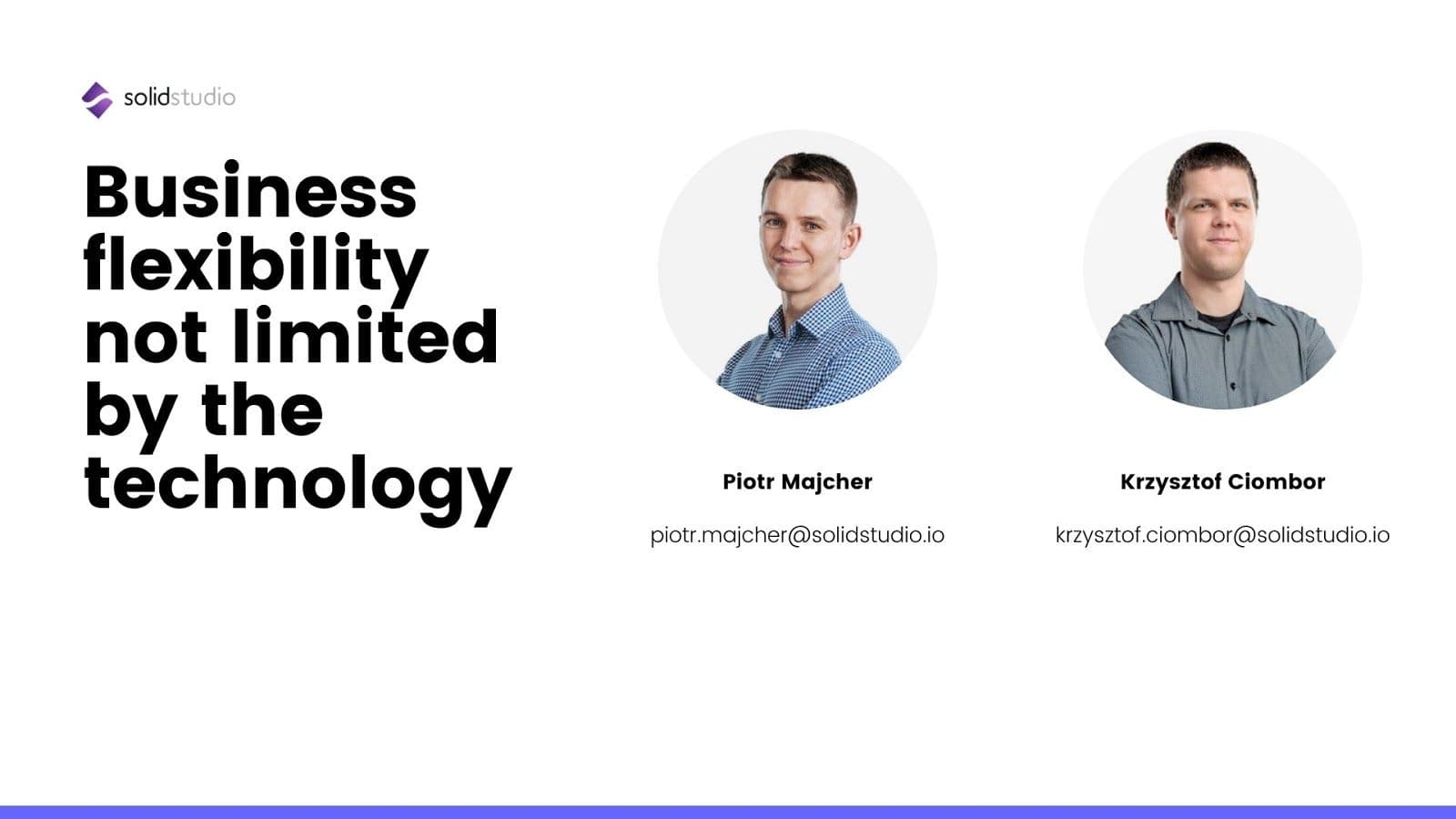Introduction
On October 14th, Piotr Majcher and Krzysztof Ciombor led a webinar in which they discussed open standards applied in emobility. Below you can find a video recording of the presented use case, and a transcript for those of you who prefer the written form.
Unlocking eMobility platform using Open Standards - video:
Unlocking eMobility platform using open standards - transcript:
Piotr: Hello and welcome to our meeting about the emobility. We'd like to talk today about unlocking the eMobility platform using open standards. OK. Two important things worth sharing before we start. The first one is, as you can see in the topic, we'd like to talk today about OCPI, but not only. We'd also like to mention different approaches to unlock the mobility platform, which are, for instance, OICP by Hubject. And other different protocols allowing to do the same, but in a different way. And the second important thing we would like to show you is that we are going to talk about the use case. It's not going to be a theoretical presentation. We would like to show you a step-by-step description of how we unlock the mobility platform using open standards. Let me just quickly go through the agenda. We'll start with a short introduction, and just ahead, we'll go through the description of how we open the eMobility platform using the open standards. We'll start from the initial state of the project. That was the point when we decided to introduce open standards to the platform. Then we'll go a bit deeper into technical details. We will describe the transition process, and at the end of that part, we will tell you a bit about the challenges and risks. The last part of the presentation is about the results. So, actually, what we achieved by opening the platform using open standards. I'm Piotr Majcher, and I am a CTO and co-founder of Solidstudio. Three years ago, I and my partner decided to stop working as consultants and we started a software house.
Piotr: Now, apart from being IT experts, we are also focused on the EV market, especially in the field of integration between different components and different partners in that market. Here with me is Krzysztof Ciombor. Krzysztof, can you say a few words about yourself?
Krzysztof: Yes. Hello, everyone. I am Krzysztof. I've been working with Solidstudio for almost two years now. I am the lead developer on eMobility project. I was primarily a backend developer specializing in JVM technologies, and I particularly love the Kotlin programming language
Piotr: Thanks Krzysztof. Just let me add a few more things about us. So, why do we share these insights? We have been cooperating with one of the European EV leaders for two years, and we have experience in developing both sides of this market. So we were responsible for delivering features normally recognized as something delivered by eMobility service provider. But we are also responsible for the development of the charge point operating platform, and we were involved in the integration between the partners using both approaches. So we were using open standards like OCPI standards and OICP, but we are also using custom APIs.
EV market forecasts
I'd like to show you a few numbers about the EV market now and in the future. I'd like to focus only on the first number. As you can see here, in 2018 in the UK, almost two percent of all cars sold were electric. I've seen quite hot Twitter news a few days ago that in Norway last month, more than half of the cars sold were electric. I think it proves that the movement of introducing electricity into transport is unstoppable. And there's no question ‘if we should do that’, but ‘how should we do that effectively?’. Before we go to the technical description of our journey from closed to open platform...
Benefits of Open Standards
Piotr: ...let’s talk a bit about the benefits of open standards. I'd like to start with the question. So the first benefit is business model optimization. The question I'd like to ask you is ‘what limits you and your company when making a decision about the integration with partners?’ We have a technical background, but we are working with sales and other business teams.
So how does it work? Normally, the ideas about integration with the partner are brought by the sales reps to the company. They have ideas, because they see some potential benefits from integrating with network parties. But before making the decision about integration, they have to know the time needed to deliver that. They have to somehow involve the delivery team, and in general, integrations with other partners are time-consuming tasks, because we have to remember about two things. If we are integrating with another company using a custom API, we are synchronizing two things. We are synchronizing models and we are synchronizing work of two teams working in a separate organization.
When it comes to the model, we know that the same things can be molded in a different way. For instance, one CPO (Charging Point Operator) may use only sockets and that's enough for their business. But another company may use a much more sophisticated model of charging infrastructure. They may use location, charge points, maybe electric vehicle supply equipment, connectors. And when we are doing the connection between those two different boards, we need to establish some common language. So we have to synchronize our models to be able to talk to each other. And the second point is synchronizing two teams, and it's always challenging, even inside one company. My experience says that integrating using custom APIs is a matter of months, not weeks or days. The business knows the answer and that is to let's assume three months. That starts during the calculation because they need to compare possible benefits coming from the integration of the partner with the cost of the delivery of such integration. And we just realized that in some cases, business decisions are driven by the cost of technical, by the cost of the delivery of the integration. That's, of course, not good.
Now, imagine a different scenario. Imagine that business doesn't have to ask tech teams about the estimation because they already know that integration with the partners normally takes four days. And for instance, there are some cases when no code has to be changed because everything is done on the platform. Such flexibility to our business can be brought by introducing open standards. The second point, our OCPs are also very important. And the point is our users. We believe that no matter what we are doing, so if you are the CPO, ESP (eMobility Service Provider), or as we are Solidstudio, a software house, users are the central point of our business. It's because scaling in most cases means that more and more users can benefit from our services.
So I’d like to start again from the question, what can make our users' life easier? According to the surveys, users are still worried about not having enough access to efficient charging stations. This is recognized as one of the most serious barriers to purchase EVs. Imagine that the user of the platform, which is not integrated with many partners, is somehow locked to the infrastructure provided. We can compare that to the situation of traditional cars. In order to buy gasoline, you are forced to look for the petrol station of the partner that you have a contract signed with. That's, of course, not a user-friendly approach. But by introducing open standards and by integrating more and more partners, with a quick integration, we can change that. And we can open as a CPO, our charge points to be used by any user on the market. And on the other hand, from the ESP perspective, we can allow our user to charge at any charge point. That brings us to that next point, which is, I believe, a long term goal for the whole market, so it's building a real European charge point network.
I think that the current state of the charge point network in the world can be compared to what we saw in the early years of electricity. There were a lot of small power plants and they produced energy without any kind of standards. Now we have one single grid in Europe and the end-user is not even aware of all those technical details under the hood. Any device can be plugged in and in any place in Europe and it just works. On the other hand, multiple power plants are also connected to the same grid. We can build the same type of experience by introducing more and more operators and mobility service providers into the same network.
I think that we can conclude the introduction now. And now we'd like to dip a bit deeper into the transitional process.
Initial state of the project - scattered, custom-made API
Krzysztof: Thank you very much, Piotr. OK, now we'll talk a little bit more about the technical details, starting with the initial state of the project, which we had a couple of years ago. And it was actually the point where we started to wonder if we can do better. We had many custom-made APIs exposed specifically to the partners that we were integrating with. And it quickly became apparent that this solution is not going to work for the future and it's not going to be maintainable. So let's start with the initial state of the project. As I said, we had multiple custom-made APIs. Those APIs were very limited in the scope of the data that we were exposing. Those APIs were only capable of exposing basic static data out to charge points, which means including the location data, for example.
But it definitely did not support full e-raming flow. And moreover, there were no real-time updates. So whenever a partner wanted to have the current state of the charge points, for example, they had to do it in a polling fashion, which is, of course, not very efficient. Also, we had multiple different APIs exposed to our partners. And as I said, this solution was not very scalable.
Main challenge with this approach was that we had to implement monitoring in multiple places in order to make sure that our APIs work correctly. We also wanted to have those APIs secured. But since we had contractual obligations different in the set up with every partner, we had to have multiple different security mechanisms in place, and we had to test every one of them independently to make sure it worked correctly
Finally, as I already mentioned, the maintainability was not so high, because any change done to our system would then need to be propagated and updated in every single one of those APIs. So, as you can imagine, this leads to an exponential explosion of the cases that we need to cover.
We need to make sure that we test them and we are exposing the correct things in production. And the biggest issue with that approach was also something that we already mentioned from a business perspective. Since we did not have the opportunity to create new integrations in short time This leads to scaling problems because we are only limited to a single user group, which are actually the users that have contracts signed directly with us. As, for example, CPO, use our touchpoints. And we can not extend this to a larger group of people that will be able to use our charge points.
Transformation process
So let's briefly talk about the transformation process and how we applied those changes from a technical perspective.
The transformation process itself is relatively simple. We first decided on the open standards that we want to use and then implemented the simple use case to confirm that the standard is really suited for our needs and we can actually implement it correctly. Then we added successive modules to enrich the API and exposed new functionalities. And finally, we achieved this huge milestone, which is the full e-roaming functionality.
This allows us to open our charged points to more external users and more external integrations. And this is like the full e-roaming functionality is beneficial for both the MSP (Mobility Service Providers) because the MSPs want to attract more users by having more access to more charging networks. This approach is also very attractive for CPOs because we want to increase the utilization of our charge points, and if we are exposing them to a much larger user base, and this means that the utilization will eventually grow, and our charge points will be used more and more. And finally, we can apply the testing and monitoring staff directly to these open standards and have centralized in one place.
Open standard selection process
As you probably are aware and you have probably seen this picture many times before, there are basically four open standards available on the current market. Of course, for the purpose of this presentation, we are focused mostly on the CPO and MSP connection, which may or may not include the clearinghouse in between. In this area, we have basically four open protocols which are widely used across Europe. This includes the OICP protocol, the Open Intercharge Protocol, which is a proprietary protocol, developed by Hubject, we have the OCPI, which is actually a peer to peer protocol, but it also can be used in a peer to hub fashion and this is currently maintained by the EV Roaming Foundation (previously, it was maintained by a Dutch company). We have the eMIP, the eMobility Interoperation Protocol, which is a kind of proprietary protocol developed by a GIREVE platform. They are a French market player and it also is a hub connection to their platform. And finally, we have the OCHP protocol. Again, to a clearing house and is maintained by the e-Clearing Net Foundation.
So even though those protocols are very similar to the functionalities they expose, like every single one of them allows you to do, the basic authorization exposes the charge information, has a possibility to get information about the session and CDR, and finally, support for e-roaming info. We still need to decide which bridge protocol suits our use cases the best. Having selected the protocol, we can continue with the step by step implementation.
It's important to realize that most of those protocols and in particular OCPI protocol allows us to do the integration step by step. What I mean by that is that OCPI protocol exposes so-called modules which can be implemented basically independently, and that allows us to start with a very simple use case. Then out successive modules along the way for the simple use case, we selected POI data sharing. This, even though it comes with the initial spike in the development effort, because we need to, for example, implement the credentials module in order to perform the full handshake flow.
After completing that once for the first partner, we can basically reuse the implementation for any successive integration with any new partner. And POI data is only about a single module, which in OCPIs the locations module. And in our OICP for Hubject, we can use EVSE data exchange in order to achieve basically the same result. So even though this process is simple, we can already see after completing that, we can already see the benefits, because we can expose to POI data, which can then be used, for example, for display purposes on external partner modules.
Having done that, as I said, we can continue with our successive model implementation along with the new requirements that come from new integrated partners and for this purpose. We can then start, for example, sharing the CDR if a partner is interested in that and finally complete the e-roaming milestone, which for OCPI I would include command sessions and CDR module and remote start-stop session for Hubject OICP protocol. By doing that, we can already start switching existing partners and deprecating the legacy integrations in favor of using open standards. This allows us to successfully remove those custom made APIs and centralize everything within this one open protocol. But that's not the end. We can push it even further and include additional modules like, for example, tariffs, token and charging profiles to improve this platform even more and expose more functionalities to our users.
Main challenges
OK, let's talk about the challenges or risk factors that we encountered along the way and explain what are the main problems and what you should be aware of? OK, so first of all, this is a brief overview of the challenges we encountered. The situation may be different for your company, but in general, we believe that those are accurate representations of everything that everyone is trying to use open platform struggles with. This includes actually a standard selection, many internal processes and data models to the open standards, applying some modifications and extensions to the standard, migrating to a newer version. And finally, the necessity of supporting multiple open standards and open standard versions.
First of all, accurate standards, selection, as we described. There are multiple standards available on the market. So it's important to realize which standard you should implement. This is, of course, dictated by two factors. If we want to achieve wide market coverage, we should probably support the standards which are used by most of the players on the market. But it quickly turned out that this is actually difficult to find out. And it may come only from experience or by, for example, being a member of this larger EV market or EV platform. For example, the EV Roaming Foundation, if you are a member, they may have some data about that. This is particularly important for OCPI where the latest version is 2.2, the 3.0 is in progress, but actually, the most used one is still the 2.1.1 Version.
Selecting the appropriate variant is also important,if you want to apply additional features that are needed for your company, like, for example, supporting the charging profiles and thus enabling the smart charging because this is available only in OCPI 2.2 and it's actually not supported in previous versions. So depending on the use cases in your company, you may want to implement a different standard.
When it comes to matching internal processes and data models to the standard, it comes in two ways.
So first of all, as we already mentioned, you for your purposes internally may model the data differently and the OCPI or OICP or any other open standard requires you to do so. That may need additional transformation/mapping layers in between your internal data models and the open protocol itself. So even though this representation you may already have in your system, in order to fulfill the open standards requirements, you will probably need to remap them to comply with the schema, when it comes to the process adjustments. This is particularly important for the CPI protocol, where this protocol is bi-directional. That means that it supports both a push and pull source. This is not usually the case for developing rest APIs.
For example, where it is mainly about getting the data and there is no active push. However, by doing the bi-directional communication, we achieve real-time updates where we can immediately push, for example, the EVs status change to our partners. And thus they can, for example, show it to the user if a charge point is available or not. I also want to mention the data quality, and this is a part of the processes adjustments since we want to ensure the best experience for both our integrations and our partners, but also for our users.
We want to make sure that the data we're exposing is actually of high quality, which includes, for example, checking the location data, if it's accurate, checking the street name, if correct, et cetera. So some partners are already doing that on their side. For instance, Gireve has their own team, which handles data quality. But for some integration, it is up to you to make sure that the data you're exposing is of high quality.
When it comes to standard modifications and extensions, this is again driven by both sides. It can be driven by us or it can be driven by our partner. What we mean by driven by us is that sometimes we actually want to expose more data than the standard provides. Imagine a case where you as a CPO have a platform for gathering telemetry data from a charge point, and you want to share it with telemetry data with your partner. But there is no property for doing that inside the open standards. If there is an agreement between you and your partner, you can proceed with extending the protocol and thus exposing more data for this particular integration. This is very useful in some cases, but the modification itself can be also driven by our partner, which is a very prominent case in OCPI 2.1.1 where there is actually a slight gap in the standard itself. Basically, there is no property to properly connect CDR to a session. So some partners are forcing you to adjust the standard and again. For Gireve for example, they introduced their own property called authorization idea, which they're using for these purposes. But it means that you will need to adopt the standard on your side and comply with those requirements if you want to integrate with Gireve when it comes to new standard migration.
So, as we already mentioned, the OCPI 2.1.1. version is the most widely used and adopted version on the market. Both version 2.2 Introduces some major changes, which, for example, enabled the smart charging, so you may be tempted to do the upgrade to the latest version. But this also needs to be coordinated properly with the partner you want to integrate with. And it's not always so simple.
Finally, we want to mention that there will be at least for the next couple of years it will be necessary to support several open standards for two reasons. The first reason is that those standards are constantly evolving and they serve different purposes. So if you want to integrate, for example, with Hubject you are basically forced to use OICP protocol. But the other reason would be to enable more peer to peer integrations. You would want to go with OCPI, but the reality for the next couple of years is probably that we either end up with this status quo where we need to have our support for multiple standards.
There are a couple of predictions that it may happen that there will be some kind of unification of the standards, and that will be one open standard. It's up to discussion whether or not this is a probable scenario. But if not, and if the open standards are there on the market, we may need to support them for the future.
Summary
So to conclude this section, we want to compare this current status with the status that we had before. So all of the issues we had previously are now solved. For monitoring, we have a single centralized place where we can monitor our APIs and make sure that we are not doing anything wrong. For security, it's not only about a single entry point but also about the unified mechanism where previously every single API of ours could be secured using a different mechanism like basic authorization. Some API can use authorization talk and now they're all forced to use the authorization mechanism provided by the standard. And finally, maintainability. And it should be pretty obvious any change applied directly in our system, can be updated only in one place and propagated to all our partners. It also includes easier testing because we can use some open-source testing tools. We can use interoperability tools to confirm that our APIs are working. Finally, there are also some events called plugfests where everybody gathers and tests their integrations all together to make sure that everything works. If everyone is speaking the same language, which is in our case the open protocol, they can communicate seamlessly and confirm that their APIs are working correctly.
Piotr: Thank you Krzysztof for taking us on a journey of opening the platform, using open protocols. I'm sure that this type of information would be very useful before someone decides to introduce open protocols onto their platform.
This is actually the last thing we'd like to share with you, and these are the results of what we did. And we needed four months in order to introduce OCPI into the charge point operation platform. And after that, we were asked by the business ‘How long does it take to integrate the next partner?’ and we estimated the effort to several days. It was about four days. It means that we reduce effort to integrate a partner by 95 percent.
I think that does answer the question that I asked you when we started, how to make our business not limited by the technology. Thank you. That's the end of our presentation and we still have the space for the questions. So if you have any questions, please, use the chart on the right side, and we will do our best to answer.
OK, so you see the first question from Chris. Could you briefly describe some main differences between, OICP and OCPI. How about the cost effectiveness of OCPI? Is it worth a shot? I think this is a question for Krzysztof
Krzysztof: Sure, I can try to explain. So the main difference between OICP and OCPI would be the connection type because OICP's strictly pure to hub connection and Hubject in this example. Where the OCPI is an open protocol which allows both peer to peer and peer to hub connection. Now, in terms of the properties that are exchanged through those protocols, the OCPI is actually more flexible and includes more data. This is especially important, for example, for the German market, where we need to have the signed meter values included in the standard for Eichrech conformity, which is a German specific case, but it's still needed for the open protocols when it comes to the cost effectiveness.
This is rather a question of what is your use case and how you want to integrate with the partner. If you can do a peer to peer connection and this suits you best, it's probably good to try the OCPI. But if you want to integrate the subject, there's no other way. And to use the OICP.
Piotr: Thank you Krzysztof. And I hope that answered the question. Here we have another question from Michael. Do you operate on your own network or do you support other networks in those integrations? Solidstudio is a software house and we are supporting our partners, who are looking for technical support. So we have an EV market background so we know how to do that, but we don't have ours as a Solidstudio, we don't have our own network. Please let me know if that answers your question.
And we can go to another one from Adam. Question: What is the adoption of OCPI among EV charger manufacturers or suppliers? As Krzysztof mentioned, in order to know such details, we would have to be the member of some bigger organization, some organization that connects similar companies. We know that those four open standards that were presented are widely used, and we have an experience that since we introduced that OCPI into the company, we already have a few other partners that are willing to use that. We also have one partner that used our custom API and now is willing to switch. So I only can say that the adoption is quite, quite big, but I can't give you an exact number.
OK. And the next question: in your opinion, what are the missing features you would like to see in the future of OCPI versions?
Krzysztof: So first of all, I think the standard is relatively good for the cases that we are apparently trying to do, considering the whole EV market. But for the future, they would definitely need to be supported for the upcoming things like the new ISO 15118 standard, which is about the plug and charge functionality, which basically means that you can skip the whole authorization process because the car itself will be authorized within the charge point. So I would like to see OCPI supporting that, maybe not for the features of the OCPI, but I would really like to have a well-defined testing suit and maybe some testing plasma for OCPI because from our perspective, especially, the handshake flow is pretty tweaking OCPI and a lot of people make a lot of mistakes there. It would be nice to have it improved for future integration.
Piotr: Thank you Krzysztof. That was the last question we have for now. Let's wait five minutes more. And we have another question, from the US? Some are saying there are problems with PKI governance. Can you please discuss the role of PKI in OCPI?
So by PKI, I mean Private Key Infrastructure. So it's not included, at least in the version 2.1.1 OCPI defines the shape of the data that are replaced by their partners. So it's rather the definition of the in short, JSON's that they're sent from one partner to another and also defines something else. OK, so the concern is with the PKI in OCPP. Well, OCPI, but you know, OCPP. So OCPP is a bit above what is the scope of our webinar. So we are talking about the integration. OK. Sorry for interrupting, but I'm getting more and more information from Michael. So the first question was for the PKI in the context of OCPI, but it's in the OCPP. So is there a similar concept OCPP. OK.
Krzysztof: I would try to clarify that. I already mentioned that while telling you about differences between OCPI and OICP in version 2.2, we do have support for signed meter values which can be used to exchange those authorization data, and also assigned data through the OCPI protocol. As I mentioned, this is required for German conformity. But is still up to our partners to decide on the standard of the encryption and the key exchange, but it's technically supported in OCPI 2.2 but as far as I know, there are plans to improve these OCPI 3.0. I hope that answers your question.
Piotr: Thank you, Krzysztof for the support. OK. So if there are no questions. Please feel free to reach us out using our emails. If you have any questions regarding our presentation or in general if you'd like. If you are looking for support in those topics that we presented, do not hesitate to contact us. Thank you very much again for your time for being with us here. And see you next time, hopefully in the next webinar by Solidstudio.


